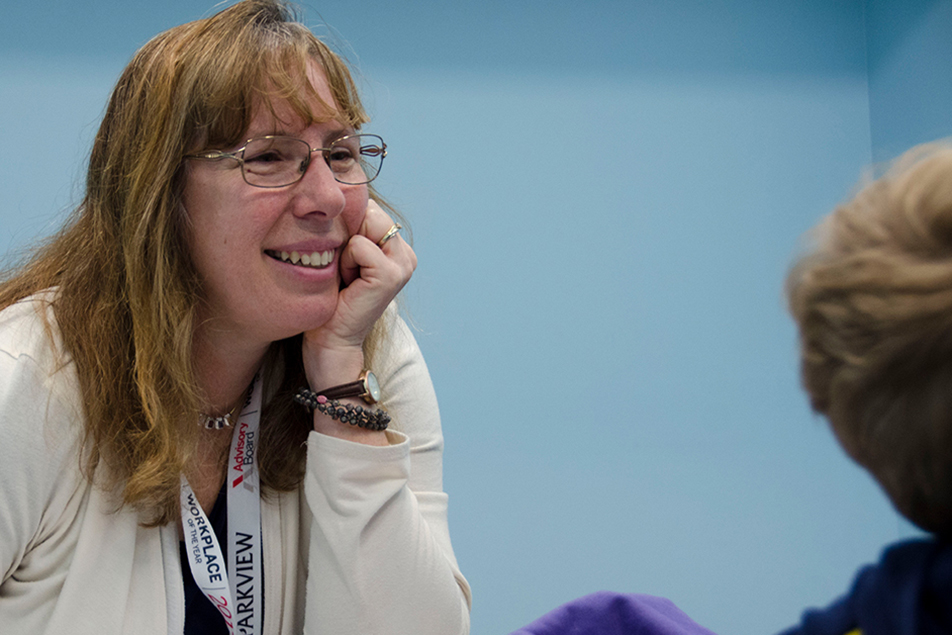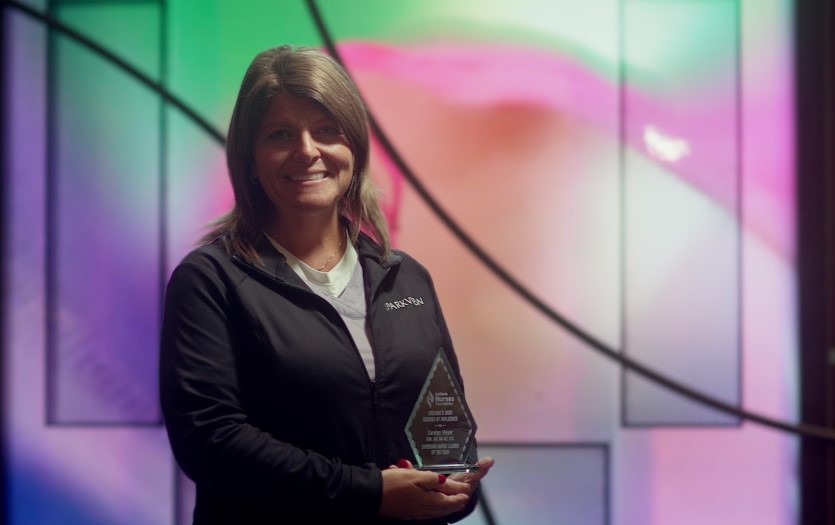
This post was written by Courtney Leach, Digital/Social Media Manager, Parkview Health.
They say a parent’s love for their child is some of the fiercest there is. It’s purity and intensity transcends all obstacles, all barriers. So, when a challenge arises – maybe physical, maybe mental – it is a call to arms for these devoted caregivers. It’s a siren signaling a need for more resources, more attention, more love.
It’s a triggered response seen frequently within the brightly colored walls of the exam rooms in the Parkview Pediatric Developmental Care Clinic. It’s here that Lisa Bergeron, MD, PPG– Pediatrics, spends countless hours screening children for behavioral and cognitive disorders, and following the development of little ones who made their way into the world a little ahead of schedule.
I told several people I was going to be following Dr. Bergeron, but, it turns out, I wasn’t saying it right. “You mean Dr. Lisa?” my brother finally corrected. Yes, that’s who I meant. For more than 22 years, Dr. Lisa, as she’s more commonly addressed, has been calming the nerves of new parents and tending to pediatric patients with her bubbly bedside manner. By the time the day came for me to ride the elevator up to Suite 210 at Parkview Regional Medical Center Entrance 3, I had collected a bouquet of rave reviews. Now I would see her bloom in her element.
Dr. Lisa’s nurse, Janet Stillman, LPN, who’s been with the physician since the start of her career, walked me back to the office, where Rachel Miller, one of Dr. Lisa’s nurse practitioners was already at work. In an attempt to meet the overwhelming demand for this patient population, Rachel and Angela Bauer, the other nurse practitioner, both assist Dr. Lisa in evaluations and follow-ups. Jen Sosebee, RN, completes the passionate group. “My team knows I expect a lot of them,” she later told me. “And they do what I ask and then some.”
And there’s plenty to do, indeed. In addition to assessing children for conditions such as autism, Dr. Lisa also sees babies in the NICU Clinic. These little ones are seen 8 weeks after they go home from the hospital, and then followed through 24 months to get ahead of any development delays.
Just after 8 o’clock, Dr. Lisa came in, with a smile so wide and so innate, her eyes disappeared almost entirely. And just like that, I got what everyone had been talking about. I, too, was instantly enamored with this divinely pleasant clinician. She jumped in immediately, explaining the benefits of early detection of autism and early intervention before she’d even taken her coat off.
Dr. Lisa graduated from Indiana University School of Medicine in 1990. She completed her pediatric residency in 1993 before pursuing a fellowship at the Cincinnati Center for Developmental Disorders. She came to Fort Wayne in 1995 and teamed up with several other physicians, including Mark O’Brien, DO, to form Appleseed Pediatrics. When Parkview decided to expand its pediatric offerings in 2008, Dr. O’Brien and Dr. Lisa became the first two pediatric providers within the Parkview Physicians Group. “I just got my 20-year pin,” she bragged.
The first patient of the day arrived around 9 a.m. This would be an evaluation to detect the potential presence of autism. We walked in and Dr. Lisa warmly greeted the parents and their sweet little boy, who was curled up in his mother’s lap. I noticed his thick, wavy hair (like a young Kennedy cousin) and perfect porcelain skin immediately. He twisted his mom’s dark locks around his fingers before pulling just enough to bring her head to the side. It’s a habit new only to me and Dr. Lisa. The mom didn’t miss a beat. She looked at her husband as they took turns answering questions about their “handsome man”.
Dr. Lisa asked them to tell her their son’s story. She wanted to know every detail about this darling little fella with the sparkling eyes. They reviewed his Checklist for Autism Spectrum Disorder (CASD) questionnaire, recalled any actions that might have seemed noteworthy in hindsight and shared patterns and facets of his nature. Detail by detail they worked with Dr. Lisa to compose their son’s unique biography; To piece together clues about what he might be thinking, feeling, trying to tell them.
These questions, along with two other sets, are tested and true diagnostic tools for Dr. Lisa. In addition to the CASD, she uses the Ages and Stages criteria to assess where a child falls in relation to the clinical parameters of where he or she should be by a certain age in five key areas: Communication, Gross Motor, Fine Motor, Personal/Social and Problem-Solving skills. She also utilizes the M-CHAT-R, a 20-question screening that can indicate if a child is at risk for autism. But these are only three of the steps in the process.
An observational test, called a Screening Tool for Autism (STAT), is also required. During this evaluation, Janet came in with a bag of toys. She handed them to Dr. Lisa one at a time, as they assessed the child’s response and interaction. First, Dr. Lisa introduced a table full of different toys, including a baby bear, blocks and plastic doll furniture. Next, she blew bubbles before handing them to the patient and encouraging him to give it a go. Next, a snack in a container with a lid. This was followed by a toy rocket, which Dr. Lisa shot off the top of her head. Next, she offered a bag of toys and sounded a noisy toy from off to the side. She concluded the test with a ball and car, which she rolled across the table while making spirited sound effects.
Through this play, Dr. Lisa was actually looking for things like turn taking, requesting help, interaction, eye contact, vocalization, shared enjoyment and imitation. “You’re supposed to administer the test with a straight face,” she said, an organic grin stretching across her face, “but that’s really hard for me. I’m so bad.”
Once the test was complete, Dr. Lisa went over the Diagnostic and Statistical Manual (DSM) criteria. Here she asked for “yes” or “no” answers to a series of questions, which can offer insight as to where a child falls on the autism spectrum, if in fact they do. This spectrum used to include both Asperger’s disorder and pervasive developmental disorder (PDD), but those terms are no longer found in the DSM. With this round of dialogue, Dr. Lisa was looking for cues related to the patient’s social communication and behaviors, sharing of interest or emotion, and ability to engage in a back and forth exchange.
As the adults continued with the final round of questions, the young boy disappeared into his signature habits. He dangled things in the crook of his hand and stared at them with an intense interest before tossing them aside. I listened as his parents described a child I’d been observing all morning; a child who wasn’t inclined to speak, make eye contact or respond to stimulus that would normally excite or startle. He was notably subdued by nature and growing sleepier by the second.
After nearly three hours in the room, asking questions and initiating responses, Dr. Lisa had a diagnosis for the family. The couple reached for each other’s hands as she confirmed that their child does, in fact, fall onto the autism spectrum. It’s a diagnosis, they admit, had crossed their minds before. As their new reality settled into the space of the room, the conversation turned to action and advocacy. “The first question parents typically ask me, is ‘Where does my child fall on the spectrum?’ or ‘How bad is it?’” Dr. Lisa initiated. “The second is, ‘What do we do now?’”
They nodded in agreement as she went into greater detail about her findings. “But, listen, you guys are great parents, so pat yourselves on the backs for doing everything you’ve done to this point,” she said. For nearly 20 minutes, Dr. Lisa ran through a wealth of resources available for this little boy. She touched on all the options, making her recommendations, ranging from “most important” to “nice to have”, along the way. Among them, Family Voices, the Autism Self Advocacy Network, Autism Speaks and the Autism Society of Indiana.
“We don’t know what causes autism,” she said, “but we do know there is a genetic component.” Autism currently affects 1 in 42 boys. She also warned of conditions that can accompany autism. Children with the condition are 20-30 percent more likely to experience seizures, for example. “But I think he’ll show us wonderful things,” she offered. She invited them to ask any questions, as her fingers furiously typed up the extensive list of resources for them to take home. She made herself unconditionally available, both in that moment and in the future. “If I don’t know the answer, I will find it for you.”
It was after noon when we walked out of the room. I felt emotionally exhausted; The parts of my brain and my heart responsible for empathy throbbing. I am a mother, after all. It could have been me and my husband in that room, processing those words. My only hope would be someone like Dr. Lisa would be on the other side of the table.
The average age of diagnosis of autism in Indiana is currently 5 years and 4 months of age. The goal is to bring that down to 3 years of age or younger. To amplify treatment, several years ago, Dr. Nancy Swigonski from Riley Children’s Hospital set up eight hubs to cover 97 percent of the state. As one of these hubs, Parkview, and Dr. Lisa’s team specifically, are working to advance the M-CHAT testing to be completed by 34 months of age when possible. Still, the wait to see Dr. Lisa is currently four months. (Less for the nurse practitioners.) This weighs on the team, as they know time is of the essence.
“Early intervention makes such an immense difference,” Dr. Lisa said. “Sometimes it can be tricky to detect, but often the signs are there. Speech and language delays are the most common indicators. While we do see that ADD combined with sensory issues can be mistaken for autism, other times, it’s that the parents just aren’t ready to accept the diagnosis. And that’s OK. I try to lead them with my thoughts and then let them make decisions. With pediatrics, it’s about what the parent experiences, too. We’re treating the whole family.”
Such an enormous demand, paired with her passion for the cause, leaves little downtime. I asked Dr. Lisa how she maintains balance, particularly with two kids of her own. “My husband stays home,” she said, “and that helps immensely. But honestly, when I go home, I do things with my kids first. And I just remind myself that it will all get done. It might be later than I’d like, but it will get done.” That task list includes volunteering for her son’s kindergarten teacher on her afternoons off, an activity Dr. Lisa has enjoyed since Robby, who is now in 7thgrade, sat in those tiny chairs himself.
Like most physicians will tell you, it’s the charting that consumes the majority of Dr. Lisa’s time out of the exam room. But perhaps more so given the diagnosis involved. “Insurance coverage can be tricky,” she said. “So, I want to put in as much detail and as many examples as possible. I need it to be incredibly clear and accurate. I translate my notes and it almost becomes a book. Then I summarize all of that into a letter that I send to the parents.”
While Dr. Lisa would like to have follow-up appointments with every kiddo she sees, she simply doesn’t have capacity. In addition to lengthy assessments for autism, the physician also sees babies who spend time in the NICU. It’s a facet of her job that brings its own set of highs and lows. “I’ve seen heart-wrenching cases where addiction came into play, and then there’ve been foster situations that were so warming,” she said. “And most parents do a wonderful job. The main thing is to get these babies on track with their development.”
Dr. Lisa and the nurse practitioners use the Ages and Stages criteria to help caregivers gauge their baby’s progress and appropriate expectations. They move the needle for what the child should be doing on a daily basis, based on their delivery date, rather than due date. This keeps goals in perspective for new parents and allows the clinical team to keep tabs on any delays.
We had two NICU follow-ups just after lunch, and for a woman who loves fresh-faced infants (me) this was a little slice of heaven. Since one of her appointments canceled, Rachel joined us to scribe for Dr. Lisa. These checkups are essential for babies born premature, as we know the risk of developmental delays is higher. “Premature little ones often have a good deal of medical issues,” Dr. Lisa said. “But they also tend to catch up fairly quickly. The resiliency of kids amazes me.”
As the petite patients showed off their newest tricks – cooing and grabbing at paperwork – Dr. Lisa gave them a thorough examination, encouraging and praising their mommies every chance she got. (There might have been some cuddling and silly faces from our threesome as well.) Both received an enthusiastic set of thumbs up from their doctor.
Our final patient of the day was already waiting when we completed the second NICU follow-up. It was a young boy Dr. Lisa had seen twice before. She had performed a STAT assessment on him at a prior appointment and was still contemplating either an autism diagnosis or a global development disorder. Dr. Lisa would go over the CASD questions with the boy’s mother and then assess his behavior from there.
“Sometimes it’s not so clear cut,” Dr. Lisa told me before we went into the room. “We want to be right and not misdiagnose.” This is why, in addition to sensory issues, she factors in socialization and other behavior patterns as well. She observes every child as if she’s truly meeting them for the first time, and it’s imperative she uncover every little detail about them. She is a collector of narratives; a curator of original characters.
In this case, the young boy with the warm brown eyes so big they could melt your heart, was displaying a significant amount of regression. Dr. Lisa’s series of questions … “Does he like to spin” … “Do you have to do things a certain way?” … “Does he respond when you call him?” … became background noise as my attention went to this adorable guy. Just a hair older than my youngest, I knew what this age looked like. He wanted his fish-shaped crackers and juice box just like my little one would. But when the juice was gone, his reaction was more commanding.
And his hands … his hurried little hands. They clapped rapidly, sporadically as the conversation carried on behind him, apart from him. He raised his fingers up just even with his eyes and tapped the tips of them like he was clicking Morse code, the slightest sound escaping his lips. With every gesture, his mom made sure Dr. Lisa was taking note. “This is where he is, all the time,” she said, with watery, tired eyes. “It’s like, we can’t get to him.”
It was no coincidence we were seeing a young boy for this second assessment. Autism is 4x more likely to occur in boys than girls. In 1993, if you had a child born with autism, your chances of having another child with the condition were 4 percent. Now, you have a 16-20 percent chance. “The instances are higher,” Dr. Lisa told me earlier in the day, “but we’re not sure why.”
This would be another notch for the statistic. A confirmed autism spectrum disorder diagnosis. As the words left Dr. Lisa’s mouth, tears began streaming down his mother’s face. It was a release of acceptance and submission and the acknowledgement that, though she did everything right, some things are just out of our control as parents. And what parent can’t put themselves there – in that chair, with that sobering reality? I cried with her. Because I am her. I want my children to thrive in this world. I want them to experience all the joys their little hearts can hold. And the thought of that looking like something different for them makes me feel helpless and small.
But there was little time for our tears. Before sharing her extensive list of resources, Dr. Lisa first offered something else. “You didn’t do anything wrong,” she said, absolutely. “In fact, you’ve been so proactive with his care. Now let’s get him what he needs so he can be the best he can be.”
When we walked out, everyone else in the clinic had gone home for the day. It was just us. I apologized for being so emotional in the exam room. And, while Dr. Lisa confessed to crying with families herself from time to time, she spent more of her words professing her appreciation for the role she plays in these special lives. “These days, there is so much available to these families. And yes, it can be hard, but I feel so blessed to have this job. If you’ve met one person with autism, you’ve met one person with autism,” she said. “This diagnosis doesn’t change who they are. I just love these little kids. They’re so wonderful.”
Parkview opened an Applied Behavior Analysis (ABA) Clinic to provide one-on-one ABA therapy to kids 18 months to 7 years with a diagnosis of Autism Spectrum Disorder (ASD). The clinic serves kids who are covered members of a Parkview Signature Care health plan at this time. The intention is to work with other health plans to expand availability to additional families.
Want more Day in the Life? See:
My day following Dr. Sharma's fellow
9 hours with a cardiothoracic surgeon



